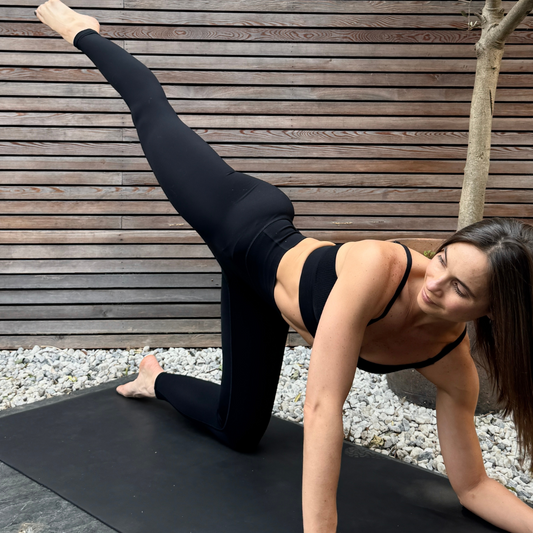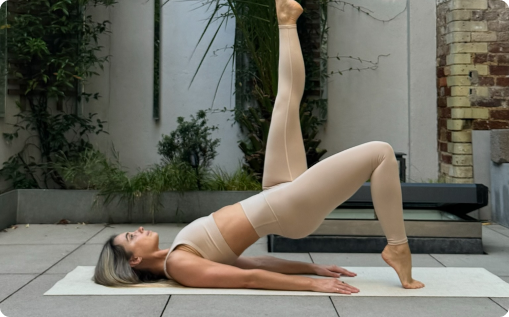While traditionally associated with rehabilitation, flexibility and light core work, Pilates is increasingly being recognised as a way to build full body strength, particularly when practised with progressive overload and time under tension.
However, some believe that Pilates doesn’t count as strength work in the same way as traditional strength training. So, can Pilates really be considered a form of strength training? Let's discuss...

What is strength training?
Strength training is any exercise that uses resistance to increase muscle growth. It involves activities where muscles work against a force, such as lifting weights, using resistance bands, performing bodyweight exercises, or using machines.
The key outcome of strength training is progressive overload – the gradual increase of resistance to continuously challenge muscles. This is what drives muscle growth and builds muscle mass efficiently.
Strength training is highly effective for building strength in your major muscle groups, but for optimal and long-term physical health, it’s important to consider other factors like flexibility, joint stability, core strength and posture.

How Pilates IS Strength Training
Pilates, particularly when practised with progressive overload (with the likes of resistance bands and weights) and time under tension, can absolutely be considered a form of strength training. It involves controlled movements and resistance to build strength. Here’s how:
Bodyweight Resistance
Many Pilates exercises use your bodyweight as the primary source of resistance e.g. plank to pike, hovers, push-ups, lunges – to name just a few of many. These movements target your stabilising muscles to build strength and endurance.
Pilates Equipment
A lot of contemporary Pilates classes incorporate equipment like resistance bands, weights and Pilates balls. These make certain exercises more challenging by activating additional muscle fibres e.g. a side lying leg press using a resistance band in a Pilates class can mimic the effects of a leg press on a machine at the gym.
Eccentric Muscle Work
Many Pilates exercises place a unique emphasis on eccentric contraction, which is the lengthening of muscles under tension. Exercises like a roll up challenge muscle strength but also focus on improving mobility, flexibility and posture. All important factors for improving total body function.
Core Engagement
Pilates focuses on the deep core muscles, including the transverse abdominis, obliques and pelvic floor. This emphasis on core strength enhances overall functional strength, thereby also improving posture, balance and stability.

The Extra Perks of Pilates Strength Work
Full Body Strength AND Balance
Unlike traditional weightlifting, which often isolates specific muscle groups, Pilates engages multiple muscles at once, helping to build strength while also improving balance. This balanced approach can also reduce the risk of injury and help keep muscle and joint pain at bay.
Functional Fitness
Pilates mirrors natural movement patterns, making it easier to transfer the strength you gain to everyday activities – such as carrying groceries/kids/pets, climbing stairs and even sitting. This makes it an excellent way to build functional strength.
Joint-Friendly
Gentle on the joints, Pilates is a great option for those recovering from injuries or managing conditions like arthritis. It strengthens the muscles around the joints, enhancing stability without excessive impact.

So, what's the ideal balance?
A balanced fitness routine doesn’t have to pit Pilates against traditional strength training. Instead, try these strategies to get the best of both worlds:
Add Resistance to Your Pilates
Incorporate resistance bands or small weights into your sessions to level up your Pilates workouts.
Combine Pilates and Traditional Strength Work
Alternate weightlifting days with Pilates workouts and stretches for a well-rounded, functional fitness routine.
Opt for Pilates on Chill Days
Pilates is a perfect medicine for more chill days, enhancing mobility, flexibility and muscle recovery. Opt for more gentle Pilates workouts on these days, or a light Pilates stretch.

If you're unsure where to start, try our Pilates Strength Challenge that combines the best of both worlds. This is a 4-week challenge that includes two Pilates x strength fusion classes each week, alongside more traditional Pilates workouts and stretches.
If you want to trial the Pilates x strength fusion classes fusion exclusively of the challenge, you can find them here!





